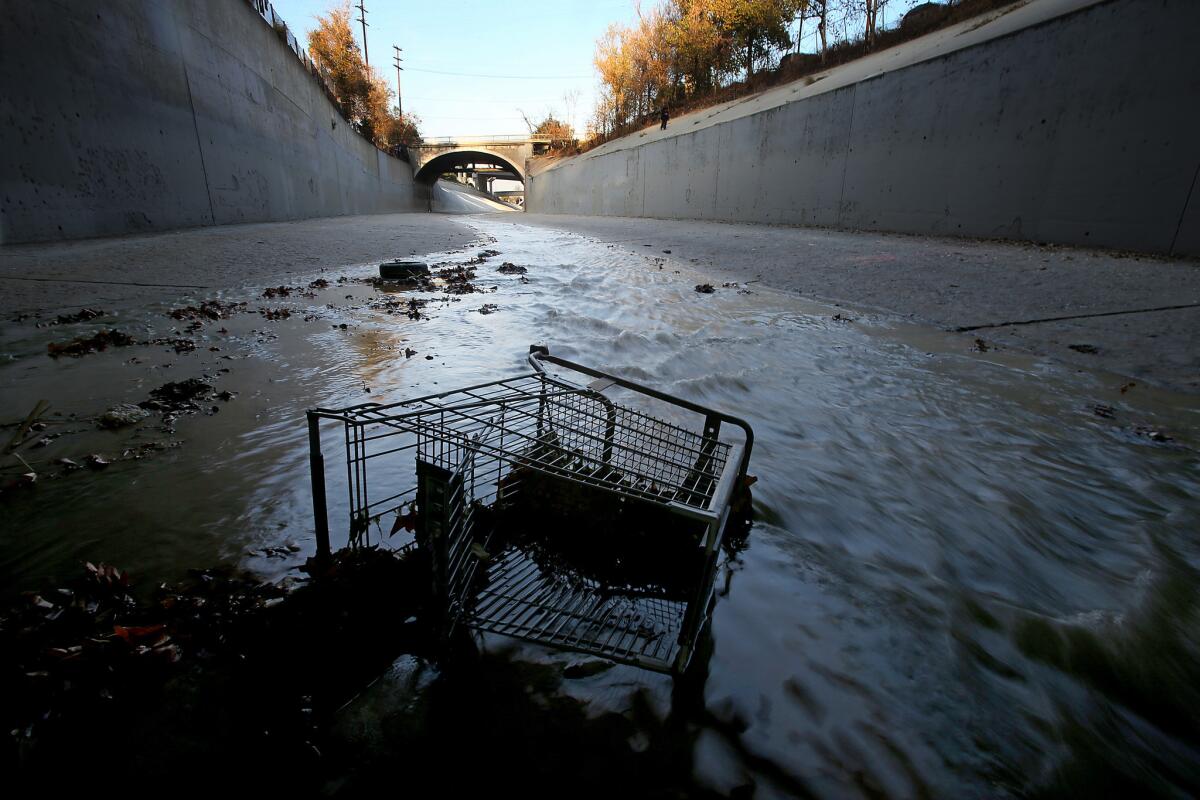Big plans, and concerns, surround L.A. River’s revitalization

- Share via
City engineers, public works officials and developers stood on a hilltop just north of downtown on a recent weekday and gazed at a low-lying railroad yard dotted with weeds on the far side of the Los Angeles River channel.
To the uninitiated, it was a mildly depressing vista of concrete, unwanted vegetation and old buildings. But that’s not what the people gathered on this hilltop saw.
“You’re looking at a game-changer for Los Angeles — the epicenter of the transformation,” said Omar Brownson, executive director of the Los Angeles River Revitalization Corp.
City officials are negotiating to buy the 42-acre Taylor Yard from the Union Pacific Railroad Co. because they see a chance to make this last undeveloped parcel on the river the starting point for an urban renaissance.
Their plan is to restore the river and open it to new recreational opportunities, leading to billions of dollars in investment and eventually transforming the channel into an upscale amenity for Los Angeles.
“It will be a river coastline for this part of the city,” said Barbara Romero, a city public works commissioner.
The city’s plan hasn’t yet won federal approval, but it is already changing neighborhoods and industrial zones along the waterway.
With little fanfare, restaurants, professional offices, art studios and others have moved into communities along an 11-mile stretch of the river scheduled for the first improvements. Speculators are buying up warehouses and vacant land, anticipating a grand future for what has been L.A.’s most neglected natural feature.
As inviting as the changes are to many Angelenos, they are not universally praised. Rents are rising sharply in river-adjacent communities, many of them home to low-income residents who say they have heard nothing from the city to ease their fears of being forced from neighborhoods they will no longer be able to afford.
And some environmental groups that worked for years to revive the river say they are losing their voice to development interests and their allies in City Hall. Developers want to reshape the corridor for profit and not necessarily to enhance the river for everyone to enjoy, the groups say.
Plans pending
Final plans and funding for the L.A. River restoration project are pending with the U.S. Army Corps of Engineers, which manages the river as a flood control channel.
Mayor Eric Garcetti and other city officials are lobbying federal officials for a plan that would spend $1 billion in local, state and federal money over several years to overhaul much of an 11-mile soft-bottomed stretch of the river between Griffith Park and downtown. A less costly option would provide about $450 million.
The corps’ decision, expected early next year, will determine how much money the federal government will give to restore portions of the river for habitat and recreational amenities including bikeways, hiking trails, parks and kayak launch points.
Those enhancements are estimated to trigger billions of dollars in residential, commercial and office development along the entire 51-mile length of the river. The Revitalization Corp. says the project could generate up to 18,000 jobs and more than $5 billion in development investment over the next 10 to 15 years.
A recent brochure by Jones Lang LaSalle, a global commercial real estate services firm, contains glossy photos of river-adjacent industrial land touted as a “future hub of the creative economy … ripe for office, multifamily, and retail development.”
In Canoga Park, 25 miles northwest of downtown, a newly adopted Warner Center development plan paves the way for investors to build residential towers near the headwaters. At the river’s mouth, Long Beach officials envision riverfront villages.
In between, new riverside parks and wetlands are popping up in the communities of Maywood, South Gate, Paramount, Long Beach and elsewhere.
In Elysian Valley, a roughly 2.5-mile section of the river that is at the heart of the 11-mile first-phase section, the blue-collar community is being reshaped by hip architectural firms, design shops, art studios, craft-beer makers and restaurants.
Buyers are picking up World War II-era warehouses and vacant lots with bucolic views of the river shaded by sycamore and oak trees.
The newcomers include Golden Road Brewery, which relocated to be part of the L.A. River culture, said Brian Dewey, vice president of sales at the brewery restaurant business.
“The area was also full of the kinds of creative spaces we like: old warehouses at affordable prices with room for dining rooms, fermenters and loading docks,” he said.
Art Yanez, owner of FSY Architects, said he bought land and moved into the area five months ago because of plans for the river and the growing artistic community. “We’ve already gotten offers to sell, but I turned them down,” Yanez said.
A few blocks away, architect Kevin Mulcahy of RAC Design Build said the firm opened in a “tired old warehouse” two years ago.
“The explosive growth here is something you feel and know at a visceral level,” Mulcahy said. “At the same time, it is worrisome to hear others talk about the scale of potential development they believe is yet to come — a Century City superimposed on the river.”
The city and the Revitalization Corp. are collaborating on plans to designate 10 Elysian Valley streets that dead-end at the river as “Rio Vista” access points for hikers and bicyclists. Later this year, construction will start on a futuristic $6-million steel pedestrian bridge that connects Atwater Village with Griffith Park.
Nearby, Taylor Yard is to become a park of wetlands threaded by bike paths framed by retail, office and residential development.
The city also has its eyes on a still-operating rail yard northeast of the Twin Towers jail, hoping the property can become an urban village of residential towers, shopping and green space with pedestrian links to downtown. But Union Pacific staunchly opposes the plan to abandon its downtown rail center at a time when it is investing $100 million in upgrades.
Critics’ concerns
Critics of the city’s plan argue that the rush to develop the river corridor will place an unsupportable burden on sewers and streets in working-class communities that straddle the waterway. They also wonder whether it will displace families that for generations have called riverfront communities home.
“As things get more attractive, they get more expensive and then folks who live below the income line are impacted,” said Joe Edmiston, executive director of the Santa Monica Mountains Conservancy. “Gentrification is the fundamental public policy issue that must addressed.”
Old-timers remember similar issues from the past. Many Los Angeles residents opposed construction of five major freeway systems over a 35-year period but were powerless to stop them. Longtime residents of Chavez Ravine were forcibly uprooted in 1959 to build the stadium where the Dodgers now play.
Cecelia Dominguez, 60, is among those who fear for the future. She lives in Elysian Valley.
“My husband’s family was among those displaced from Chavez Ravine,” Dominguez said. “When we moved to Elysian Valley in the 1970s he vowed, ‘They will never take us away from here.’”
The median price of a house in Elysian Valley rose 21% over the last year to $443,400, according to Zillow.com, an online real estate database. “That’s a large increase for Elysian Valley,” said William Yu, an economist at the UCLA Anderson Forecast. Countywide, median house prices were up 16% over the same period.
City officials say they have not spoken out about such concerns because they are focused on an immediate goal: persuading the Army Corps to invest hundreds of millions of dollars on river improvements.
In an interview, Garcetti said his staff is “doing whatever we can do to balance affordable housing with access for children and students and making sure [the river corridor] doesn’t turn into a playground for the rich.”
“What we’re looking for are creative community builders to work closely with neighborhoods that abut the river,” he said. “And that’s always a balance — everyone wants the good of gentrification and not the bad.”
Major development along the river is essential, said David Bergman, a professor of urban planning at the Southern California Institute of Architecture. Any large-scale ecological restoration would have to include development of surrounding property to help pay for it, he said.
“Forty years ago, when we wanted a library, community center or park, there was money for it,” Bergman said. “Not anymore.
“To pay for a new park, for instance, you have to upgrade the land around it with development opportunities,” he said. “Any time you do that, there are going to be winners and losers.”
FOLAR, or Friends of the Los Angeles River, a 20-year-old nonprofit credited with igniting interest in restoring the river to a more natural state, is also voicing concern. The organization feels overshadowed by what it sees as the Revitalization Corp.’s largely pro-development efforts.
“It’s as though they came in and said, ‘Thanks, FOLAR, but we’re taking it from here,’” FOLAR board Chairman Alejandro Ortiz said.
Los Angeles attorney Robert Garcia, executive director of the City Project, a nonprofit dedicated to broadening access to parks and open space for inner-city residents, said he foresees tumultuous times over the future of the river.
“Historically, the city treated its river as an industrial wasteland with low rents for homes and small businesses,” Garcia said, seated on a park bench near a downtown area proposed for riverside development. “Now, developers are urging commercial buyers to snatch up land along the river’s shoulders.
“Sadly,” he said, “a land grab is underway.”
More to Read
Sign up for Essential California
The most important California stories and recommendations in your inbox every morning.
You may occasionally receive promotional content from the Los Angeles Times.












